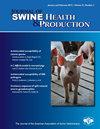新生仔猪铁剂量对血液学指标、断奶前和断奶后生长性能以及断奶后组织矿物质含量的影响
IF 0.7
4区 农林科学
Q3 Agricultural and Biological Sciences
引用次数: 6
摘要
目的:评价出生时给铁量对猪生长性能、断奶前后血液流变学及断奶后组织矿物质浓度的影响。材料和方法:将杂交猪(n=70)分配到5个铁剂量中的1个(0、50、100、200和300mg铁),在第0天通过注射给药。在第0、1、2、3、4、6、8、11、17、22、23、24、25、29、38和52天采集体重和血液样本。对所有血液样本进行全血细胞计数(CBC)分析。在第22天、第38天和第52天,获得每次处理3头猪的组织,用于分析微量矿物质(Fe、Zn、Cu和Mn)。结果:出生时不含铁的猪生长最慢,血液学特征最低,这表明诱发了缺铁性贫血(IDA)。对于200和300mg铁处理,血红蛋白浓度早在第6天就增加,并持续增加直到第17天。出生时接受铁注射的猪的体重、其他血液学指标和组织铁含量更高。影响:出生后不久没有注射铁的猪会出现IDA,导致生长不良、血液学指标低下和组织铁储备耗尽。在出生时注射铁可以改善断奶前和断奶后的生长性能和CBC特征。血液学反应峰值的大小和时间是剂量依赖性的。本文章由计算机程序翻译,如有差异,请以英文原文为准。
Effects of iron dosage administered to newborn piglets on hematological measures, preweaning and postweaning growth performance, and postweaning tissue mineral content
Objective: To evaluate the effect of iron dosage given at birth on pig growth performance, the course of the preweaning and postweaning blood profile, and postweaning tissue mineral concentration. Materials and methods: Crossbred pigs (n = 70) were assigned to 1 of 5 iron dosages (0, 50, 100, 200, and 300 mg iron) administered by injection on day 0. Body weight and blood samples were collected at day 0, 1, 2, 3, 4, 6, 8, 11, 17, 22, 23, 24, 25, 29, 38, and 52. All blood samples were analyzed for complete blood count (CBC) profile. On day 22, 38, and 52, tissues from 3 pigs per treatment were obtained for analysis of trace minerals (Fe, Zn, Cu, and Mn). Results: Pigs receiving no iron at birth had the slowest growth and lowest hematological profile demonstrating that iron deficiency anemia (IDA) was induced. Hemoglobin concentrations were increased as early as day 6 and continued to increase until day 17 for the 200 and 300 mg iron treatments. Body weight, other hematological measures, and tissue iron content were greater for pigs that received an iron injection at birth. Implications: Pigs that did not receive an iron injection shortly after birth developed IDA resulting in poor growth, low blood hematological measures, and depleted tissue iron reserves. Supplying an iron injection at birth improved preweaning and postweaning growth performance and CBC profile. The magnitude and timing of peak hematological responses was dose dependent.
求助全文
通过发布文献求助,成功后即可免费获取论文全文。
去求助
来源期刊
CiteScore
1.80
自引率
0.00%
发文量
29
审稿时长
>36 weeks
期刊介绍:
The Journal of Swine Health & Production (JSHAP) is an open-access and peer-reviewed journal published by the American Association of Swine Veterinarians (AASV) since 1993. The aim of the journal is the timely publication of peer-reviewed papers with a scope that encompasses the many domains of applied swine health and production, including the diagnosis, treatment, management, prevention and eradication of swine diseases, welfare & behavior, nutrition, public health, epidemiology, food safety, biosecurity, pharmaceuticals, antimicrobial use and resistance, reproduction, growth, systems flow, economics, and facility design. The journal provides a platform for researchers, veterinary practitioners, academics, and students to share their work with an international audience. The journal publishes information that contains an applied and practical focus and presents scientific information that is accessible to the busy veterinary practitioner as well as to the research and academic community. Hence, manuscripts with an applied focus are considered for publication, and the journal publishes original research, brief communications, case reports/series, literature reviews, commentaries, diagnostic notes, production tools, and practice tips. All manuscripts submitted to the Journal of Swine Health & Production are peer-reviewed.

 求助内容:
求助内容: 应助结果提醒方式:
应助结果提醒方式:


